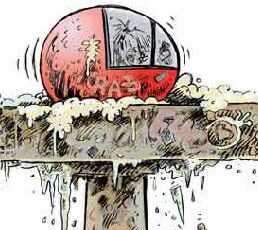
Light Rail Now/Light Rail Progress can be contacted at: Light Rail Now! |
Ken Avidor is a Minneapolis cartoonist and creator of the PRT is a Joke website. Cartoons in this article are his own. Currently, there's a lot of public discussion and debate about Personal Rapid Transit, or PRT – particularly in Minneapolis, where promoters are once again trying to procure public funding for a starter project. PRT proponents are masters at making extravagant claims and promises for this or that version of their techno-dream. However, it's important to recognize that PRT does not currently exist in successful public operation, and, in all likelihood, never will. (For a technical explanation of PRT, see Personal Rapid Transit – Cyberspace Dream Keeps Colliding With Reality.) PRT has a solid 30-year record of failure. Its main purpose in recent years seems to have been to provide a cover enabling its proponents to spread disinformation about real, workable transit systems. Except for the occasional laboratory-scale prototype, PRT actually "exists" largely in computerized drawings, in promotional brochures, and in cute, ever-successful animated simulations on the internet. The unsubstantiated claims of PRT proponents are always presented in the present tense as if the system is a proven success ... which, of course, it certainly is not. Promoters never seem to fail to bash real transit, such as light rail (LRT), as "old fashioned technology". Sadly, the media rarely check the veracity of PRT publicity and propaganda. But, the truth is out there. In the 2001 OKI [Ohio-Kentucky-indiana] Central Loop Study for metro Cincinnati, for example, the OKI study's engineers (Parsons Brinkerhoff) found many serious flaws in the PRT design. That study cost the taxpayers in the Cincinnati area a cool $625,000. There have been several attempts at building a PRT system over the years – Morgantown in West Virginia, ULTra and Aramis in Europe, Raytheon's Rosemont, illinois fiasco ... to name some of the more prominent examples. All have failed to live up to the claims of being "faster, cheaper, better" than conventional mass transit. So if it doesn't work, why does it keep coming back for taxpayer funding year after year (as is currently happening in Minnesota and New Jersey)? What is PRT's real purpose? Basically, PRT is a stalking horse for the highway construction industry. PRT proponents can say things that the highway boosters could never say, such as "people don't like to ride with strangers". This anti-transit propaganda divides and conquers the opposition to highway projects. I saw this happen with the I-35W Access Project in Minneapolis. This is perhaps why Taxi 2000/Skyweb – an aggressive would-be PRT vendor – has the support of, and shares a lobbyist with, SEH, the engineers for the "Excess Project" for highway expansion. PRT was also used as an excuse by pro-highway/anti-transit Republicans in the Minnesota Legislature's 2004 session to block funding for the North Star commuter rail line. This is why, perhaps, Taxi 2000/Skyweb Corporation's leader, Ed Anderson, refers to PRT as a "disruptive technology".
The PRT flim-flam works the same way in other states as it has in Minnesota. PRT bamboozles and confuses citizens and lawmakers about the real, workable, off-the-shelf transit solutions that can help communities free themselves from gridlock, pollution, and dependence on foreign oil. And PRT promoters are experts at this kind of swindle. They seem to operate on the principle that there's a sucker born every minute – especially among gullible journalists. But don't fall for this scam. The next time you read a puff piece in the newspaper, in a magazine, or on the internet about PRT, let them know you don't buy their con – write the publication or website and demand a real investigation of the PRT flim-flam.
Light Rail Now! website Updated 2005/01/05 |
|
|
|